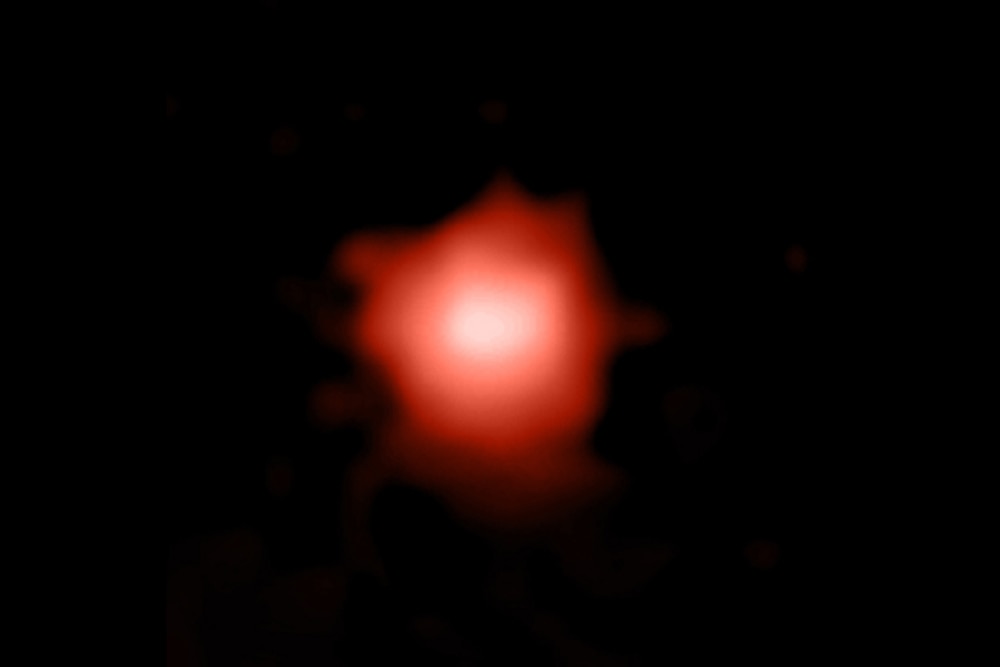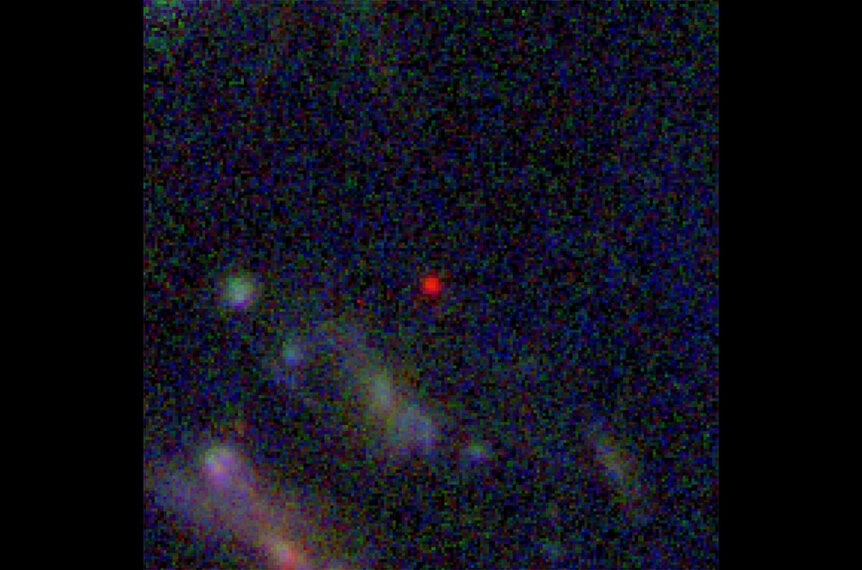Create a free profile to get unlimited access to exclusive videos, sweepstakes, and more!
Did JWST find the most distant galaxy ever seen? Maaaaaybe.
GLASSz13 may be — MAY be — the most distant galaxy ever detected.

[UPDATE: Welp. I wrote this article over the weekend and couldn't post it until Tuesday morning, and then on Monday night, literally 12 hours before this article went up, a whole bunch of different teams of astronomers posted four papers — and possibly a dozen more; I've lost track — where they've found galaxies in the JWST data that have redshifts of 14, 16, and one claim of a galaxy with a redshift of higher than 20 [paper 1, paper 2, paper 3, paper 4]. I've looked them over and while the claims look anywhere from tentative to actually quite good, what I wrote in the main article below still applies: These are candidate objects, because we can't confirm their redshifts without spectra. If, and that's a big if, but if they are confirmed this will throw early Universe cosmology into a tizzy; that z=20 galaxy would have existed some 150 million years after the Big Bang, long before we thought galaxies could gather themselves together. We're gonna need a better cosmological model.
So what I wrote below is still largely correct; I explain how these distances were found and why they're estimates until we can get more detailed spectral observations. What's no longer correct is that GLASS-z13 is a record breaker. It was… for less than a week.]
Looking through a batch of early-release images from JWST, astronomers have found a handful of galaxies that may be among the most distant ever seen, including one, called GLASS-z13, that may be THE most distant galaxy ever seen. If true, the light we see left the galaxy just 300 – 400 million years after the Big Bang itself!
But — and this is a big but — there are some caveats. One is that the journal papers making the announcement have not yet been peer reviewed, which is a critical step in the process. The second, and more important, caveat is that the method used to determine the distance to this galaxy is not exact, and can yield false positives. The gold standard for distance determination, called a spectroscopic redshift, has not yet been done. Because of these issues, the best we can say right now is that GLASS-z13 is a candidate for most distant galaxy ever seen.
JWST was used to observe a cluster of galaxies called Abell 2744, more commonly called the Pandora Cluster, a group of thousands of galaxies about 3.5 billion light-years from Earth. These observations are part of the JWST early release program, which means they were deemed of such great interest to astronomers that the data were made public immediately, so that scientists could examine them as soon as possible.
Two teams of astronomers immediately jumped on the observations [link to Paper 1, and Paper 2]. They combed through the data looking for distant galaxies, taking advantage of a technique called photometric redshift.
Hydrogen is the most abundant element in the Universe. A galaxy forming in the first few hundred million years of the cosmos will be lousy with it. An atom of hydrogen can absorb light at different wavelengths — think of them as colors — but any light with a wavelength shorter than 0.0912 microns has enough energy to knock the electron off the atom, ionizing it.
The outcome is that any light in the galaxy with a shorter wavelength (what astronomers call bluer light) will get absorbed by any hydrogen floating around, but light with a longer wavelength (redder light) will pass through. We don’t see bluer light coming from that galaxy while we do see redder light, a phenomenon called the Lyman break.
Also, the Universe is expanding. The farther away a galaxy is from us, the faster it appears to recede. An object moving away from us will have its light redshifted, meaning the wavelength will stretch out, similar to the Doppler Effect which makes a motorcycle make the familiar EEEEEEoooooooowwwwww sound as it passes you.
Here’s where this gets fun: Combining these two effects, a very distant galaxy will have its light redshifted hugely. The Lyman break is in the ultraviolet part of the spectrum, but by the time that light gets to Earth it will be redshifted into the infrared where JWST can spot it.
The photometric redshift technique looks at the light from the galaxy observed in several filters that see specific wavelengths of light. In the short wavelength filters the galaxy is invisible, because hydrogen absorbed that light. In the longer wavelengths it suddenly pops into view, because hydrogen let that light pass through. By seeing which filters the galaxy appears in, or doesn’t appear, astronomers can estimate its redshift, and therefore its distance.
Both teams of astronomers looked at many galaxies in the JWST images, and both found one deeply red blotch that appears to have a very high redshift: The galaxy’s light appeared to be stretched by a factor of 13 – 14 times. This is designated by the letter z, where z = 1 means the wavelength is doubled, z = 2 means it’s tripled, and so on. That’s where the galaxy name comes from: The observations were made by a project called the Grism Lens-Amplified Survey from Space, or GLASS, and it has a z of about 13.
And that’s the problem here: The exact redshift can’t be found by the photometric method, only an estimate. The actual redshift has to be found using spectroscopy, breaking the light up into not a handful of colors but hundreds or thousands of them, creating a spectrum. Then the Lyman break redshift can be better measured. Other diagnostic techniques using the spectrum can also be used to more precisely nail down the galaxy’s distance as well.
JWST spectra of these galaxies are planned, but until those are done and vetted in the scientific publishing process we cannot say that GLASS-z13 is the most distant galaxy ever seen.
In fairness, the observations and analysis done by the astronomers do look pretty good, and I expect that when spectra are taken they’ll confirm the redshift. But they also might not, so we have to be careful.
But let’s say this galaxy’s redshift really is around 13. What does that mean?
Well, for one thing it would mean the light we see from this galaxy took about 13.4 or 13.5 billion years to reach us, which in turn means we see this galaxy as it was when it was at most 400 million years old. But the observations indicate it already has about a billion stars or more in it, which means galaxies formed stars very rapidly after the Universe itself formed.
Interestingly, another galaxy seen in the data, called GLASS-z11, also seems to show signs of already forming a disk, like the disk of our own Milky Way galaxy. It would be small, only a few thousand light-years across — the Milky Way’s disk is 120,000 light-years wide, and there are hundreds of billions of stars in our mature galaxy — but the fact that it exists at all shows galaxies were gathering themselves together and forming structure earlier than many models predict. GLASS-z13 is unresolved in the JWST images, meaning it’s just a dot, so nothing can be said about its structure except that it must be smaller than very roughly 5,000 light-years wide.
Another interesting aspect of all this is that just seeing these galaxies at all, assuming their distances are real, is a surprise. JWST only sees a small part of the sky at once, and models of how galaxies form predict they’re rare. Finding two of them, and maybe more, in a single JWST image indicates they are more common than thought. If the distances pan out, it’ll mean rethinking what we understand about galaxy birth and evolution.
Record-breakers are cool, but they’re just the start. What we really need see is a population of these galaxies, observations of lots of them in different parts of the sky that also tell us what kinds of elements are in them and what they look like, so we can figure out the statistics of them. Are GLASS-z11 and –z13 outliers, flukes? Or is there a huge population of luminous star-forming galaxies blasting out light just a few hundred million years after the birth of the Universe?
Only then can we really start to divine what was going on in the very young Universe. The good news is that JWST is expected to make a lot of these deep observations, and follow up with spectroscopy. We don’t have answers yet, but we very well may have them soon.




























